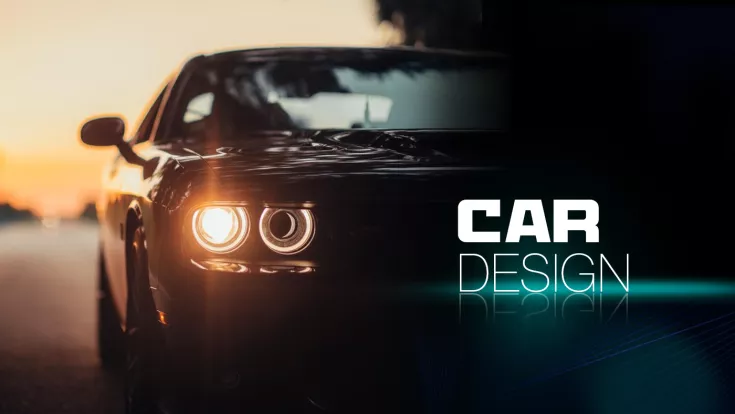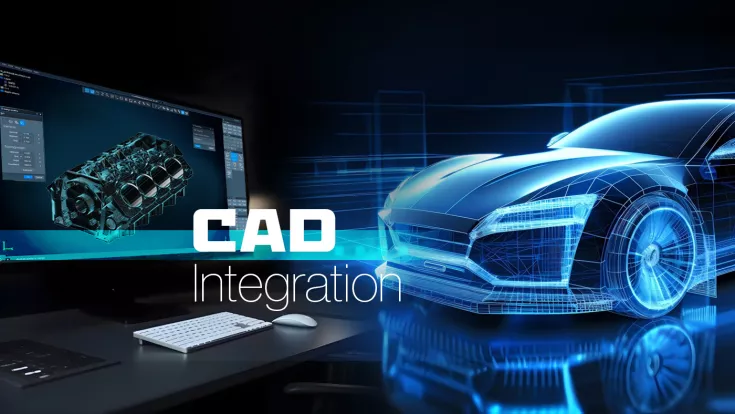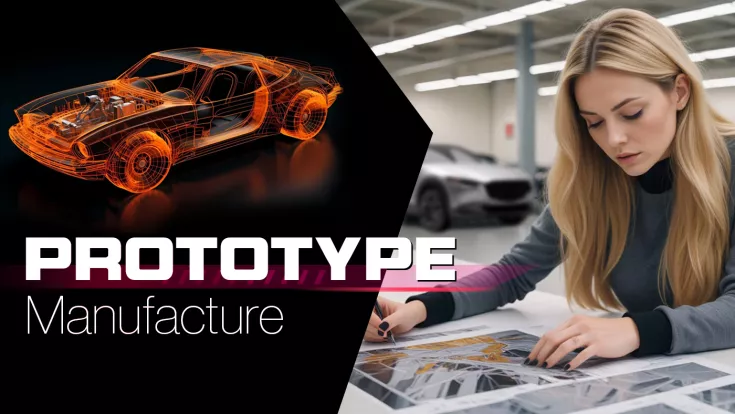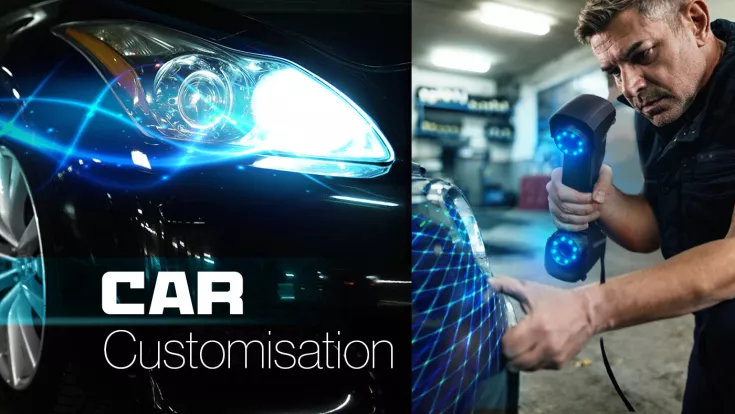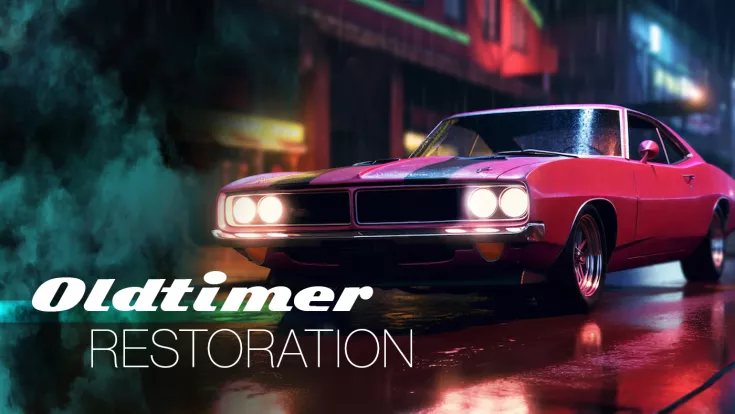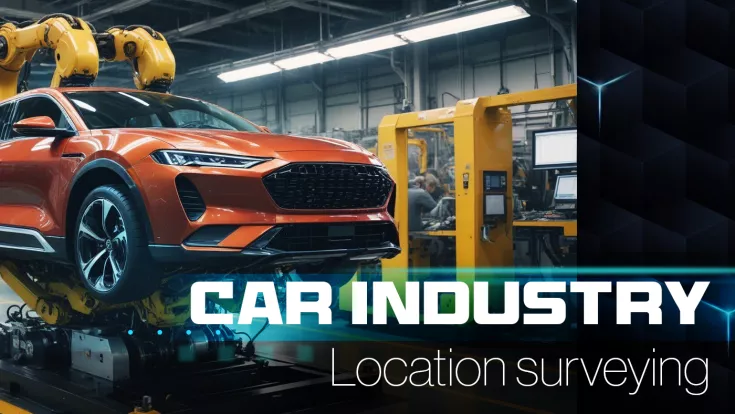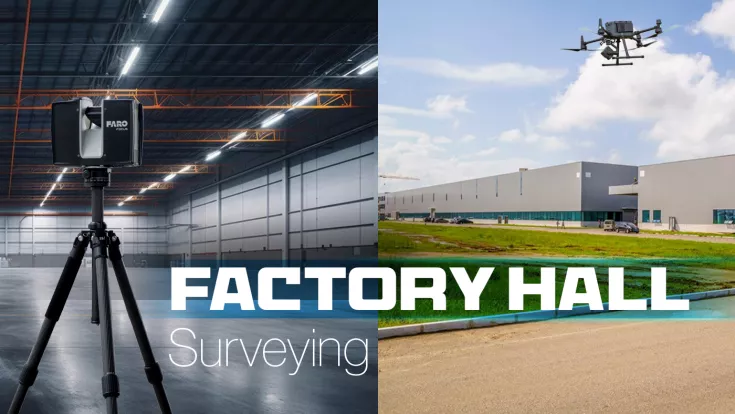3D Scanning in Automotive Industry
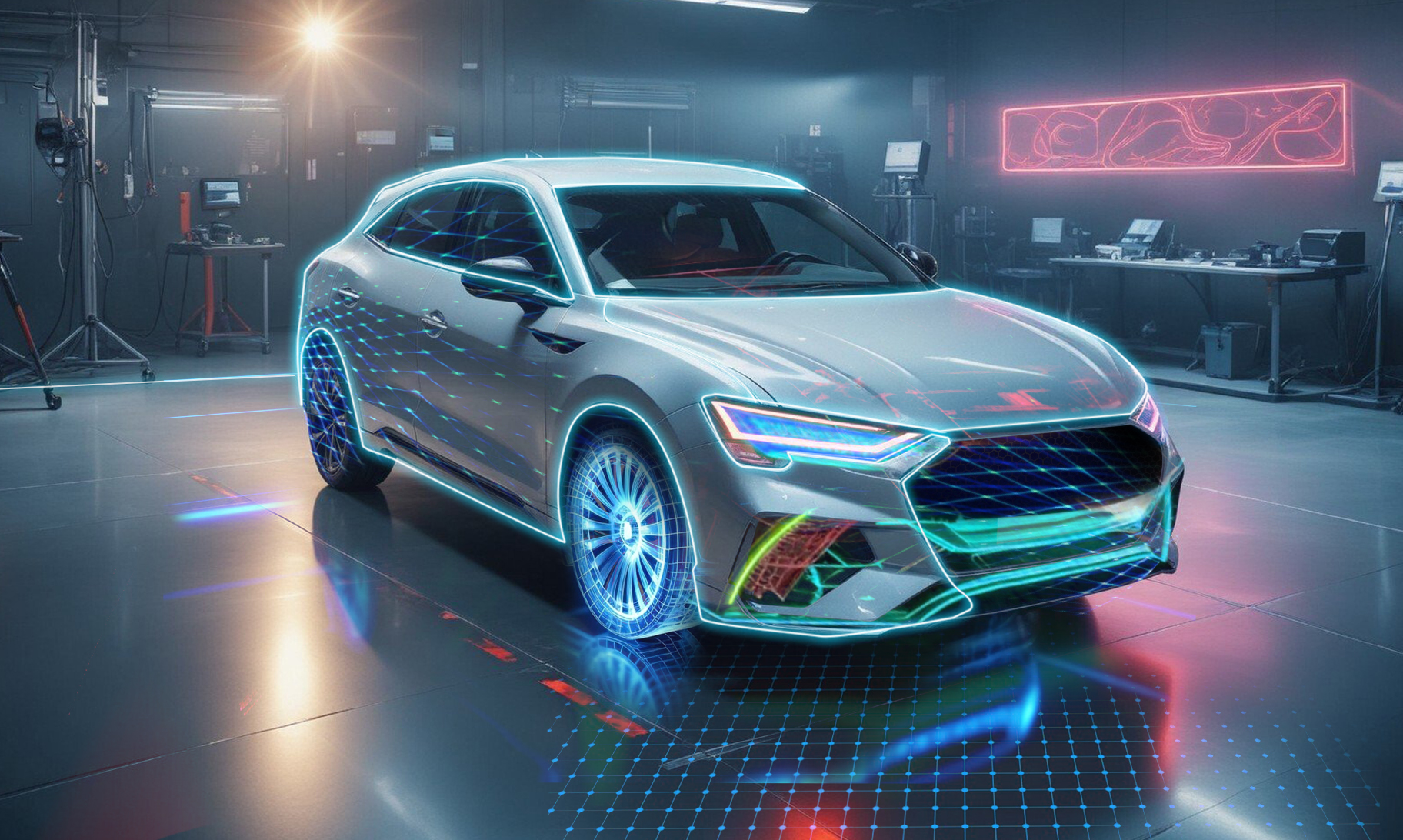
TitleInnovation for development, production & quality assurance
The automotive industry relies on high-precision measurement technology – and 3D scanning is an indispensable tool. Modern laser scanners allow components, vehicles and production processes to be digitally captured with the highest accuracy.
Whether prototype development, quality assurance or reverse engineering – 3D scanning enables efficient processes, reduces sources of error and accelerates the market launch of new models. Companies benefit from precise measurement data that can be integrated directly into CAD and simulation software.
TitleCar design
The use of 3D laser scanners in automotive design is currently an integral part of the automotive industry. The use of 3D laser scanners is revolutionizing vehicle development by accurately digitizing physical models, speeding up creative processes and significantly improving the quality of the design.
- Concept development & design process
The early stages of automotive design are critical to the development of successful vehicle models. Designers often create physical models or prototypes out of clay or other materials to visualize initial concepts. These models serve as the basis for the aesthetic and functional design of a vehicle. This is where 3D laser scanning technology comes into play: by using 3D laser scanners, these physical models can be digitally captured with high precision and imported into CAD systems. This digital capture enables the seamless integration of physical concepts into the digital design world, where they can be further refined and optimized.
Digitizing the models allows designers to create and modify different iterations of the vehicle quickly and efficiently. Changes to the design can be made in real time, increasing flexibility and creativity in the design process. By integrating 3D laser scanning into the design workflow, development time is significantly reduced and more precise and innovative vehicles can be developed.
- Precise modeling & surface analysis
Another key advantage of 3D laser scanning technology in automotive design is its ability to perform precise modeling and surface analysis. Body parts and surface structures must be designed with extreme precision to ensure aerodynamic efficiency and aesthetic quality. Surface capture can be done with mobile handheld scanners such as the Artec Leo, FARO Freestyle, or scanners from Shining3D.
These types of 3D laser scanners capture every contour and nuance of a physical model with the highest accuracy. This data is integrated into CAD systems where designers and engineers can further process it.
3D laser scanners provide data that enables detailed analysis and optimization of surface quality. This is particularly important for the aerodynamics of the vehicle, which has a direct impact on fuel consumption and driving stability.
TitleIntegration in CAD systems
3D laser technology plays a crucial role in the field of computer-aided design (CAD). By using 3D laser scanners, detailed 3D models of vehicle components and assemblies can be created. These models serve as the basis for the further development and optimization of design and construction. The precision of 3D laser scanners makes it possible to integrate precise measurement data into the CAD software, allowing design errors to be detected and corrected at an early stage.
- Data capture & import into CAD
The integration of 3D laser scanners into CAD systems represents a significant advance that is revolutionizing the automotive industry through precise data capture and the seamless transfer of physical objects into digital design and development processes.
The captured point cloud data is imported into CAD software where it is processed into detailed 3D models. The import represents an important step in the digitalization of vehicle design, as these models serve as the basis for further design iterations, simulations and analyses. By combining 3D laser scanning and CAD, engineers and designers can create precise and detailed models that enable a realistic representation and analysis of vehicle components.
The accuracy and depth of detail of the captured data allows complex geometric shapes and structures to be accurately mapped. This is particularly important for the development of body parts, which not only have to meet aesthetic requirements, but also functional requirements such as strength and weight. By integrating 3D laser scan data into CAD systems, these requirements can be met precisely.
- Design optimization & simulation
CAD systems offer extensive tools for design optimization and simulation. The inclusion of 3D laser scan data enables precise simulation of flow conditions, loads and other physical properties. This helps to identify and correct potential design errors at an early stage, reducing development time and improving the quality of the end product. By using these technologies, car manufacturers can develop innovative and high-performance vehicles.
Simulations are an essential part of modern vehicle design. They make it possible to analyze and optimize the behavior of the vehicle under different conditions. For example, flow simulations can be used to improve the aerodynamic properties of the vehicle. Load analyses help to ensure the structural integrity and safety of the vehicle. If data from 3D laser scanners is integrated into these simulations, accuracy and reliability are significantly increased.
TitleLaser scanning in prototyping
Prototype production benefits considerably from 3D laser scanning. Laser scanners make it possible to create prototypes quickly and accurately, which can then be tested and optimized. In addition to digital capture, the use of 3D laser scanners also helps to analyze the prototype in terms of shape and material to ensure that they meet the desired specifications and quality standards.
- Fast & precise prototyping
3D laser scanning has revolutionized prototyping. Traditionally, the production of physical prototypes was a time-consuming and costly process. With 3D laser scanners, physical models can be quickly and accurately captured and converted into digital prototypes. These digital models can then be edited and optimized using CAD software before going into physical production. This significantly reduces the cost and time required for prototyping and allows for faster iteration and refinement of design ideas, ultimately leading to a faster time to market for new vehicle models.
- Virtual prototyping & simulation
Virtual prototypes offer numerous advantages over physical models. By using 3D laser scan data, digital prototypes can be created and tested in various scenarios. This includes flow simulations, crash tests and other stress analyses. Virtual prototypes allow potential problems to be identified and rectified at an early stage before physical models are produced. This leads to greater efficiency and quality in the development process.
The ability to create and test virtual prototypes allows engineers and designers to quickly evaluate and optimize different design options. This leads to better decision-making and higher quality final products. In addition, the use of 3D laser scanning and virtual prototypes provides automotive manufacturers with a technology-enabled foundation to develop more innovative and competitive vehicles.
TitleInspection of vehicles with handheld 3D scanners
In inspection, 3D laser scanning plays an essential role in quality assurance. Laser scanners can be used to scan and measure vehicles and components to ensure that they meet the specified tolerances and specifications. This technology enables components and assemblies to be checked quickly and accurately, allowing errors to be detected and corrected at an early stage.
- Efficiency & precision in quality control
Handheld 3D scanners are an important tool for inspecting vehicles. These portable devices make it possible to carry out quick and precise measurements directly on site. In quality control, handheld scanners are used to check manufactured parts and assemblies for compliance with design specifications. The captured data can be immediately compared with the CAD models to identify deviations and errors. This improves the efficiency and accuracy of quality control, helping to ensure high quality standards.
The ability to take measurements directly on site significantly increases the flexibility and efficiency of quality control. Handheld scanners can be used on the production line to inspect finished parts and assemblies quickly and accurately. This reduces the need for costly and time-consuming inspections in special test laboratories and enables faster and more efficient fault detection and rectification.
- Application in production & final assembly
Handheld 3D scanners are used in production and final assembly to check the accuracy of fit and alignment of components. This is particularly important when assembling complex assemblies, where even the smallest deviations can lead to malfunctions. By using handheld scanners, assemblers can ensure that all parts are correctly positioned and assembled, increasing the quality and reliability of the finished vehicles.
Scanners that have become well established in this area are the Shining 3D, Artec Leo and FARO Freestyle models.
The use of mobile handheld scanners in production and final assembly makes it possible to ensure the quality and accuracy of the manufactured parts and assemblies. This precise recording of technical car components and structures leads to greater reliability and longevity of the vehicles and contributes to customer satisfaction.
TitleVehicle conversion & individualization through 3D scanning
3D laser scanning is used to create accurate measurements and models when fitting out vehicles, especially when customizing and individualizing vehicles. This facilitates the customization of components and accessories so that they fit perfectly and meet the high demands of customers.
- Customization & personalization
3D laser scanning enables precise customization and personalization of vehicles. Customer requests for individual adaptations can be fulfilled by capturing the vehicle geometry and creating detailed digital models. These models serve as the basis for the development and production of customized components and accessories. Precise capturing and modeling allows customizations to be implemented quickly and efficiently, increasing customer satisfaction and improving flexibility in vehicle customization.
Another advantage offered by 3D laser scanning is the personalization of the vehicle in terms of color design. By capturing the vehicle surface with 3D laser scanning and calculating it in the program with imported scan data, an exact consumption measurement can be determined in terms of paint color or film.
The ability to develop customized components and accessories offers car manufacturers and dealers the opportunity to respond to the individual wishes and needs of their customers. This leads to greater customer satisfaction and loyalty and offers a competitive advantage in the highly competitive automotive market.
- Development of special models
The use of 3D laser scanning has also contributed to the development of special models in the automotive industry. The presentation of detailed digital models provides the basis for making various adjustments and modifications required in the development of special models.
Designers and engineers can use these digital models to work faster and more efficiently than on analog models, which require more time and therefore incur higher costs. Rapid iteration and optimization of special models and their tailor-made components lead to a faster market launch of new vehicle models and variants. This in turn strengthens the innovative power and competitiveness of car manufacturers.
TitleRestoration of classic cars
The restoration of classic cars requires a high degree of precision and attention to detail. 3D laser scanners make it possible to accurately measure old and rare vehicle parts and create digital models. These models can then be used to reproduce spare parts or to document the restoration process. This is particularly valuable when original components are no longer available and need to be reproduced.
- Digital capture & reproduction
The restoration of classic cars requires a high degree of precision and attention to detail. 3D laser scanners make it possible to capture the exact geometry and surface structure of classic cars and create digital models. These models can be used to reproduce spare parts or to document the restoration process. Especially for rare and historic vehicles for which original parts are no longer available, 3D laser scanning offers a valuable solution for reproduction and restoration.
For classic cars where components are not just missing but damaged, 3D scanners can be used to precisely digitize damaged parts so that they can be reproduced later using the scan data. This is particularly important for the restoration of rare and historically significant vehicles, where original parts are often no longer available. By using 3D laser scanning, spare parts can be produced quickly and efficiently and integrated into the vehicles.
- Documentation & archiving
The digital recording of classic cars also offers advantages for documentation and archiving. The digital models created can serve as detailed documentation of the current condition of the vehicles and can be used for future restoration work or historical research. Through digital archiving, valuable information about rare and historic vehicles can be preserved and made accessible for future generations.
The ability to create and archive detailed digital models of classic cars provides a valuable resource for restorers and historians. These models can be used for future restoration projects or historical research and contribute to the preservation of automotive heritage.
TitleLaser scanner for surveying industrial sites
Surveying industrial sites with 3D laser scanners enables precise documentation of the entire environment. This data can be used to plan and optimize production facilities and processes. In addition, 3D surveying facilitates the installation of new machinery and equipment, as accurate models of the site are available to identify potential obstacles and optimization opportunities.
- Planning & optimization of production facilities
3D laser scanning is used to measure industrial sites and production facilities. The ability to create accurate digital models of production facilities enables engineers and planners to optimize plant layouts and configurations. This leads to greater efficiency and productivity of production processes and helps to reduce costs and improve quality. By using 3D laser scanning, production facilities can be planned and optimized precisely and efficiently.
- Applications & advantages in automotive industry
In the automotive industry, the data collected from site surveys is used for various purposes. One of the main applications is the planning and design of new production facilities or the expansion of existing facilities. The precise 3D models allow engineers to determine the optimal placement of machines, production lines and storage areas to maximize workflow and minimize bottlenecks.
Furthermore, 3D laser scanners play an essential role in the monitoring and maintenance of industrial sites. Regular scans make it possible to detect changes in the structure or alignment of buildings at an early stage, enabling timely maintenance and repair. This optimizes uptime and increases safety in the workplace.
- Integration with CAD systems & other technologies
The captured data is often integrated into CAD systems to create detailed digital models. These models serve as the basis for simulations and virtual planning, which can be carried out before physical implementation. Through integration with other digital technologies such as Building Information Modeling (BIM), complex interdisciplinary projects can be coordinated and optimized, resulting in more efficient and cost-effective project implementation.
- Future developments & challenges
The measurement of industrial sites in the automotive industry is in a phase of continuous development. Future technologies could improve the automation and real-time monitoring of data provision to enable even more precise and faster analysis. Challenges such as data protection, integration of IoT (Internet of Things) and the security of data transmission will also continue to be addressed to ensure the reliability and security of site surveying.
TitleFactory hall surveying with terrestrial laser scanners & UAVs
In the automotive industry, the measurement of factory buildings is also of crucial importance. The foundation of a production facility goes hand in hand with a solid and precise site survey. It is a crucial step in optimizing production processes and ensuring efficient workflows.
- Surveying with terrestrial laser scanners
In addition to surveying using GPS and total stations, factory hall surveys are also carried out using terrestrial laser scanners, which enable precise capture of the geometry and structure. This method has proven reliable for creating detailed 3D models of interior spaces that are used for planning, optimizing and monitoring production facilities.
Terrestrial laser scanners are strategically placed in various positions within the factory floor to cover a comprehensive scanning area. These scanners emit laser beams that reflect off surfaces and accurately measure the position of the reflected beams. By integrating this measurement data, precise point clouds are created that map the entire geometric structure of the factory floor. These point clouds are then imported into CAD software, where they serve as the basis for planning and optimizing production processes.
Well-established terrestrial laser scanners in this area are scanners from FARO Technologies and Artec.
- Surveying with UAV
An increasingly innovative approach to factory hall surveying is the use of drones in combination with terrestrial laser scanners. Drones offer the advantage of flexibility and mobility, as they can comprehensively capture a factory hall from the air from different perspectives. This makes it possible to scan large areas quickly and provide detailed data on the structure, layouts and conditions of the facilities. For use with UAVs, LiDAR scanners are used to accurately scan the earth's surface and cameras for orthographic images.
One of our solutions for capturing highly accurate data is the Lidaretto mobile mapping system, which you can conveniently install on drones.
The combination of drones and terrestrial laser scanners significantly optimizes the surveying process. While terrestrial laser scanners capture precise details at ground level, drones cover large areas and provide a comprehensive view of the entire site. This synergy allows for faster data collection and more accurate coverage of the shop floor environment, resulting in improved planning and efficiency on the shop floor.
UAVs also offer the advantage of safety and accessibility. They can scan hard-to-reach or dangerous areas without the need for staff to be on site, minimizing safety risks and increasing the efficiency of the entire surveying process. The collected data can be transferred in real time to CAD systems, where it can be used for modelling, simulation and optimization of production processes.
Overall, terrestrial laser scanners and UAVs enable advanced factory floor surveying that significantly improves accuracy, efficiency and safety in the automotive industry and other production environments. These technologies are playing an increasingly important role in modernizing production facilities and promoting innovative solutions to increase the competitiveness and sustainability of companies.
TitleOur services
Do you have a project that you would like to measure and digitize using modern scanning technology? Then get in touch with us and benefit from our expertise.
If you would like to carry out your projects independently, we can offer you comprehensive training in the use of terrestrial laser scanners. With this training, you meet the requirements for renting laser scanners from us in order to realize your projects.
